Islamic Architecture Wonders: Exploring Iconic Monuments of the Islamic World
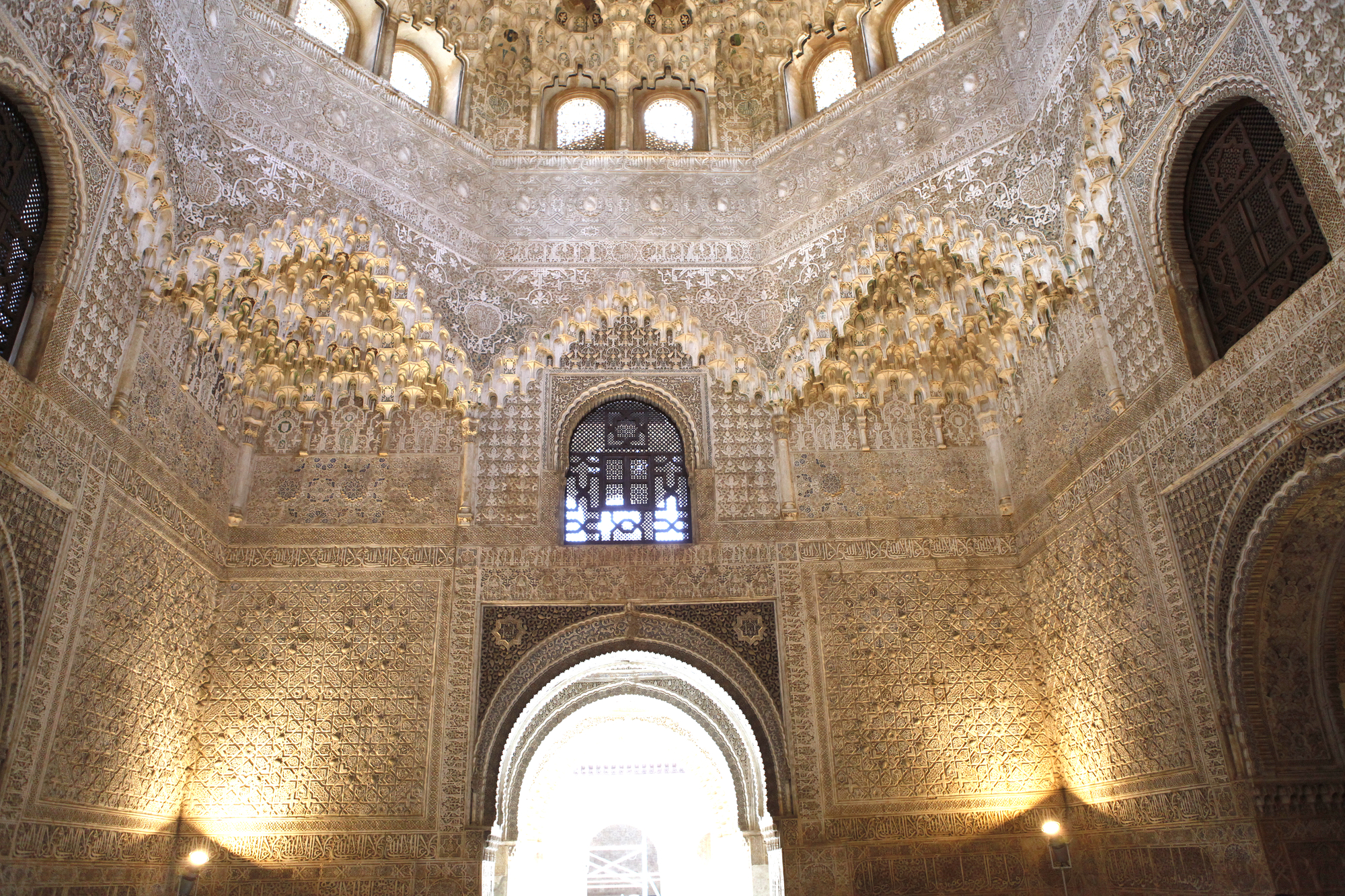
Updated On: April 17, 2024 by Fatma Mohamed
Islamic architecture is an expression of great splendour and an enduring testament to cultural achievement throughout history. Sprawling across the world from the Iberian Peninsula to the South Asian subcontinent, it encompasses an array of structural masterpieces, each telling a unique story of the civilisations that crafted them. Among the most celebrated are Spain’s Alhambra and India’s Taj Mahal, which not only embody the artistic and architectural innovation of the Islamic world but also narrate tales of power, devotion, and the passage of eras.
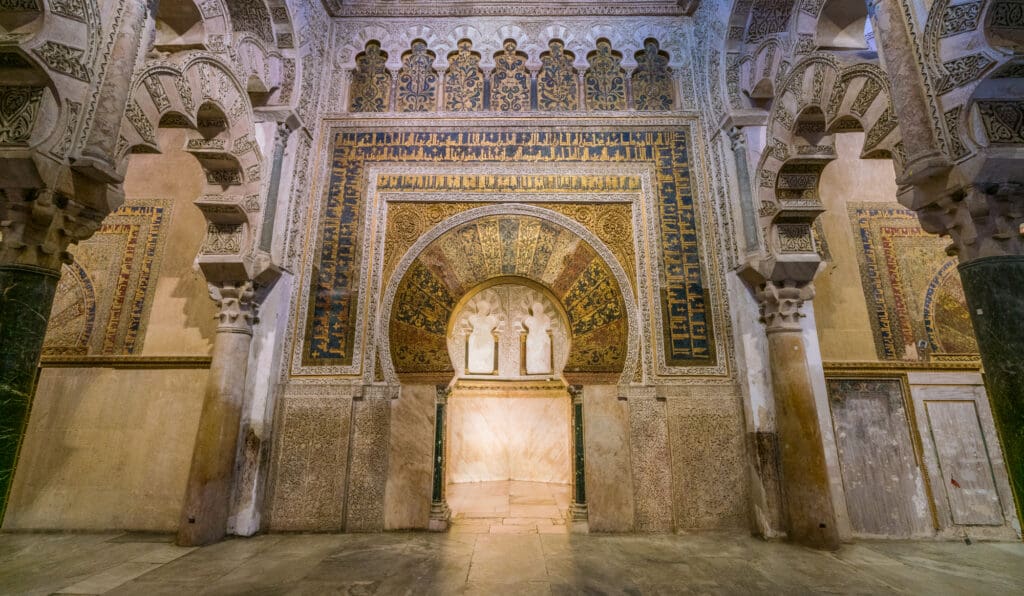
The Alhambra stands as a pinnacle of the Nasrid Dynasty’s legacy, its walls and gardens and a canvas painted with intricate artistry and calligraphy, reflecting the height of Muslim rule in Spain. In sharp contrast to the military might symbolised by the red fortress, the Taj Mahal rises as a white marble epitome of love and devotion, commissioned by the Mughal Emperor Shah Jahan for his beloved wife. Both these architectural wonders are a mere glimpse into the expansive canvas of Islamic contributions to world heritage, characterised by intricate geometries, calligraphic adornments, and monumental scales.
Table of Contents
Historical Overview of Islamic Architecture
Islamic architecture is a term that encapsulates the wide range of architectural styles that have emerged from various Islamic societies. From magnificent mosques to ingenious engineering feats, these structures reflect the region’s religious, cultural, and socio-political history.
Rise of Islamic Architecture
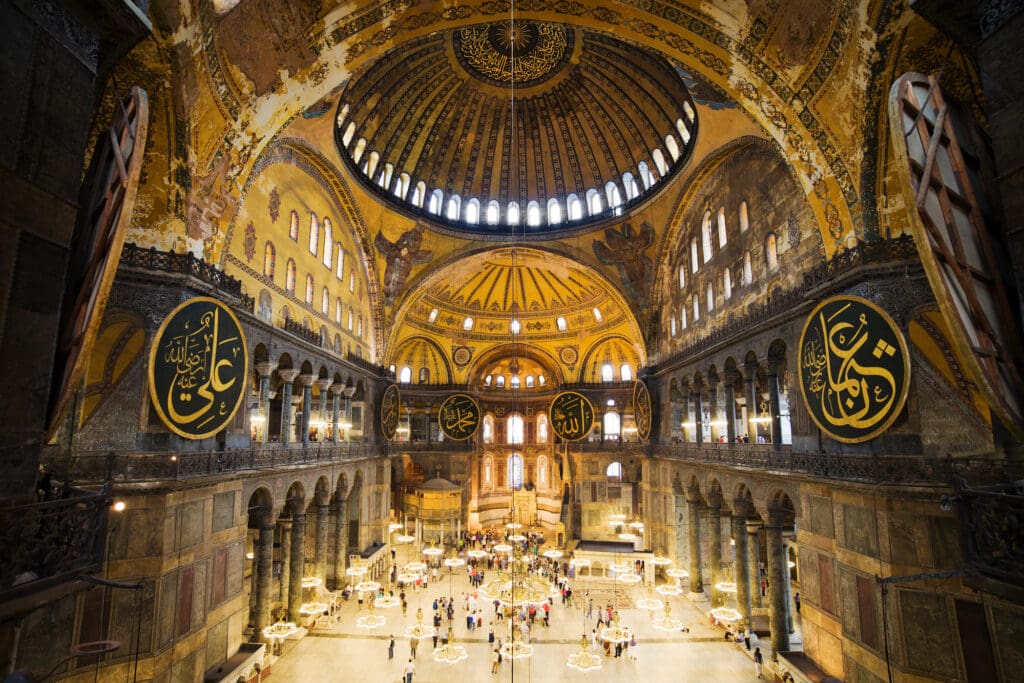
The genesis of Islamic architecture can be traced back to the 7th century, following the establishment of Islam. Early Islamic structures incorporated elements from pre-Islamic cultures like the Roman, Byzantine, and Persian civilisations, but they rapidly evolved to serve the needs of Muslim worship and community life. The mosque became the focal point of Islamic architecture, serving not only as a place of worship but also as a hub for education, social welfare, and governance.
Key features of early mosques include large courtyards for communal prayers, minarets for the call to prayer, and mihrabs to indicate the direction of Mecca. The evolution of mosque architecture over time can be seen in seminal buildings such as the Great Mosque of Damascus or the later advancement in Iranian mosques, which adopted the four-iwan design that prevails in the region.
Influential Islamic Dynasties
The dissemination and development of Islamic architecture were largely influenced by the ruling dynasties of their respective eras. The Umayyad and Abbasid caliphates oversaw the early spread of Islamic architecture, while subsequent dynasties each imparted their distinctive touch to the architectural heritage.
The Umayyad Dynasty (661–750 CE) favoured the desert palaces and the use of mosaics, as visible in the Dome of the Rock in Jerusalem. The Abbasids, establishing their capital in Baghdad, introduced innovations in geometric designs and infrastructure.
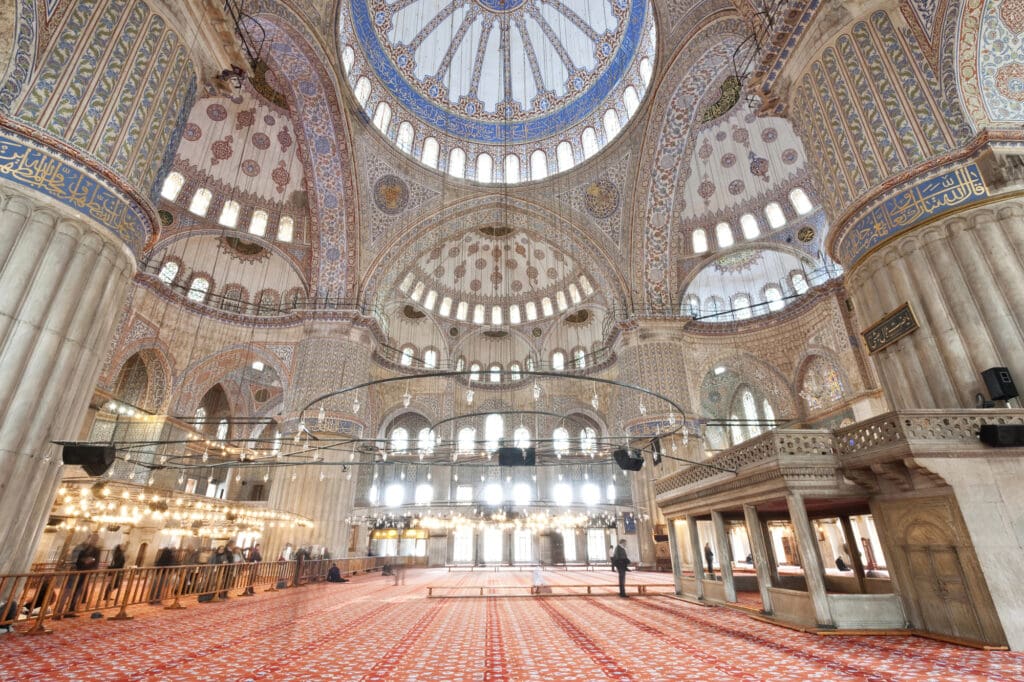
From the 11th to the 19th centuries, subsequent Islamic dynasties such as the Ottomans, Safavids, and Mughals extended the geographic and stylistic reach of Islamic architecture. The Ottoman’s use of large central domes and the Safavids’ distinctive styles influenced the skyline of cities like Istanbul and Isfahan. The Mughal Empire infused Islamic design with local Indian aesthetics to create landmarks such as the Taj Mahal, renowned for its symmetrical beauty and intricate ornamentation.
Each of these dynasties contributed unique characteristics to the architectural language, demonstrating the diversity and innovation within Islamic architecture throughout history.
Defining Features of Islamic Architectural Design
Islamic architectural design is distinguished by its emphasis on aesthetics, symmetry, and spirituality. Each element, from grand domes to intricate calligraphy, works cohesively to create an environment that reflects the cultural and religious ethos of Islam.
Use of Geometry and Calligraphy
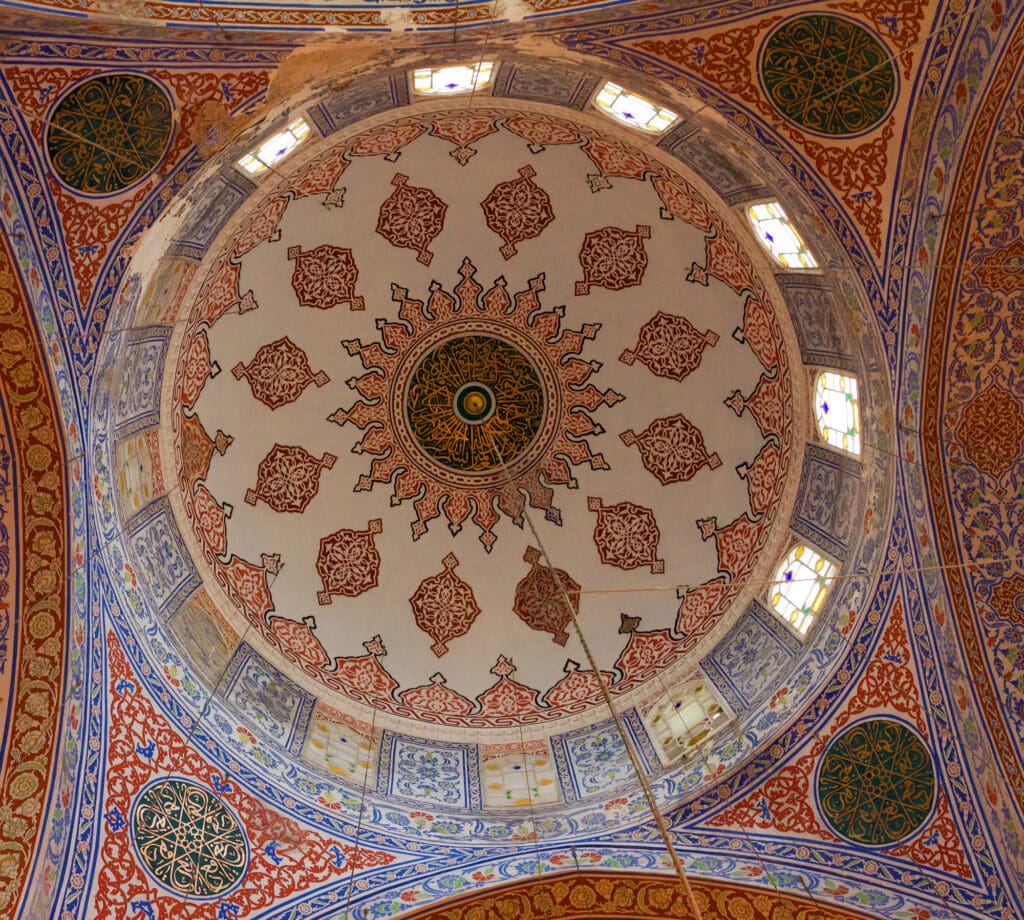
Islamic architects deployed geometric patterns and calligraphy to an extraordinary extent for both decoration and symbolism. Geometric patterns are omnipresent, whether they are formed by the repetition of simple shapes or more complex calculations, which results in designs that can be seen in a variety of settings, from grand mosques to more intimate spaces. This reliance on geometry is not only for its visual pleasure but also for its ability to symbolize the infinite nature of the creation.
Calligraphy, on the other hand, transforms Arabic script into divine art, often adorning the walls of Islamic buildings. From the sacred texts of the Qur’an that grace the interiors of many Islamic structures, calligraphy serves to inspire and remind of the religious context of these spaces.
Symbolism in Islamic Art
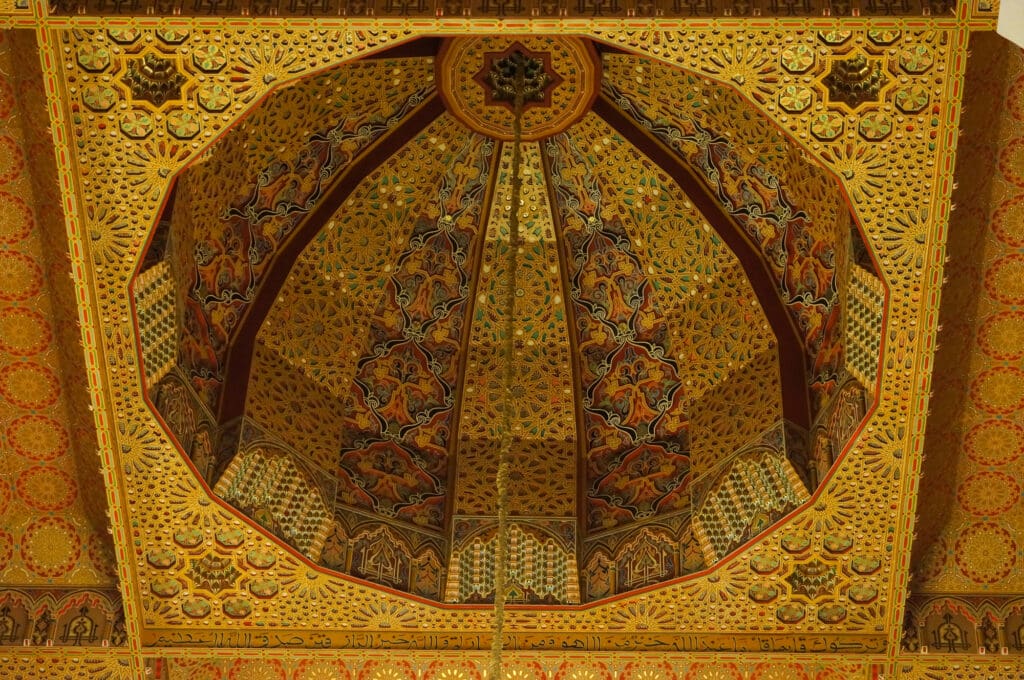
Symbolism in Islamic art is conveyed through the meticulous use of motifs and design elements. The courtyards of Islamic architecture serve as tranquil sanctuaries that invite calm and reflection and are often accented by lush gardens, representing the paradise on earth. Mosaics and arabesque contribute to the visual tapestry, incorporating floral or vegetal designs that signify life and growth without directly replicating nature.
Domes are a hallmark of Islamic architecture, soaring skyward and often clad in tiles or mosaics. They not only create impressive external silhouettes but also enhance the internal acoustics for the call to prayer, imbuing the space with a sense of the divine. These characteristic elements of Islamic art are not merely decorative features; they embody the deep-rooted symbolism and religious beliefs that are central to Islamic culture.
The Alhambra: Jewel of the Nasrid Dynasty
Nestled in the royal city of Granada, the Alhambra stands as a testament to the refined taste and political power of the Nasrid Dynasty. This palatial complex, renowned for its intricate architecture and lush landscaping, was the apogee of the last Islamic sultanate on the Iberian Peninsula.
Palaces and Courtyards
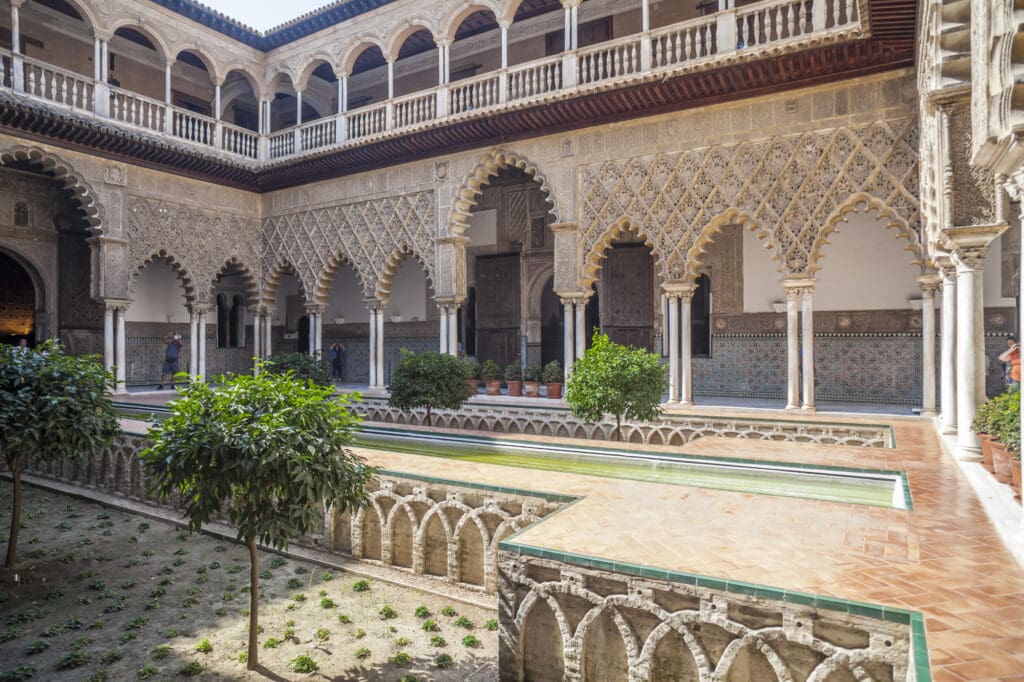
The Alhambra’s palaces are marvels of design, from their vibrant tilework to their ethereal courtyards. Central to these structures is the celebrated Court of the Lions, a courtyard unmatched in its beauty and craftsmanship. Surrounded by slim columns, the courtyard’s famed fountain – supported by statues of lions – serves as a stunning focal point. The palaces once served as the royal residence, visually capturing the grandeur and sophistication of the Nasrid emirs who called this place home.
Gardens of the Generalife
Adjacent to the Alhambra, the Generalife was the leisure estate of the Nasrid rulers, enveloping visitors in greenery and tranquillity. The gardens here are a masterpiece of landscape design, intertwining the natural with the architectural. Featuring long pools framed by flowerbeds, columnar arcades, and trickling water features, the Generalife creates a serene escape that has enchanted visitors for centuries. These gardens epitomise the Islamic tradition of crafting earthly paradises that reflect celestial harmony.
Islamic Spain and the Reconquista
In the tapestry of Islamic Spain’s history, the Reconquista stands as a significant period marking the transition from Muslim to Christian rule, particularly impacting the architecture in cities like Granada.
Granada and the Christian Influence
Granada, the last Muslim kingdom in Spain, fell to Christian forces in 1492, ending the centuries-long Islamic rule. The Alhambra, a palatial fortress complex, exemplifies the zenith of Islamic art and architecture in Spain. However, the Christian conquest introduced new architectural features, melding Gothic, Renaissance, and Baroque styles with existing Islamic designs. The Alcazaba of Granada, a prominent feature of the Alhambra, saw changes, too, although it remained largely a military fortress throughout.
Conversion of Spaces Post-Reconquista
After the Reconquista, many Islamic buildings were repurposed to serve Christian functions. Mosques were often consecrated as churches, and minarets were transformed into bell towers. The Granada Cathedral, built on the site of the former Great Mosque of Granada, showcases this transition with its blend of styles. This conversion of spaces highlights the complex layering of religious and cultural identities in Spain’s architectural heritage.
Great Mosque of Córdoba and the Cathedral Within
The Great Mosque of Córdoba, a sterling example of the rich tapestry woven from Andalusian history, showcases a harmonious blend of Islamic and Christian architecture within its walls, marking a unique chapter in the chronicles of the medieval era.
Architecture Reflecting Faith and Politics
At the heart of Córdoba, in the expanse of the majestic Mosque-Cathedral, we find architectural testimony to the confluence of faith and the shifting sands of political power. The Mosque, originally constructed by ‘Abd ar-Raḥmān I in the 8th century, was a symbol of Islamic faith and Umayyad power in Al-Andalus. It has since undergone various modifications, reflecting the changing times.
The Mihrab serves as a focal point in a mosque, and in the Mosque of Córdoba, it is notably characterized by its horseshoe arches, beautifully adorned with intricate calligraphy and geometrical designs, serving not only religious purposes but also as a political symbol of the Umayyads’ link to the earlier caliphates.
With the Reconquista, the mosque was reconsecrated as a Cathedral with alterations, adding a nave in the 16th century, embodying the Renaissance era’s stamp on the edifice. Known for the harmonious coexistence of Medieval Islamic and Christian Renaissance elements, the building represents cultural continuity amidst religious change.
Unlike any typical cathedral, the Mosque-Cathedral of Córdoba stands out as a historical palimpsest, deeply imprinted with the spiritual sagas of those who reigned and those who consecrated it anew.
The Taj Mahal: Monument of Love and Devotion
The Taj Mahal stands as an eternal testament to the love between Mughal Emperor Shah Jahan and his wife Mumtaz Mahal. Constructed from pristine white marble, it combines stunning architectural elements and tranquil gardens that embody devotion.
Architectural Elements of the Taj Mahal
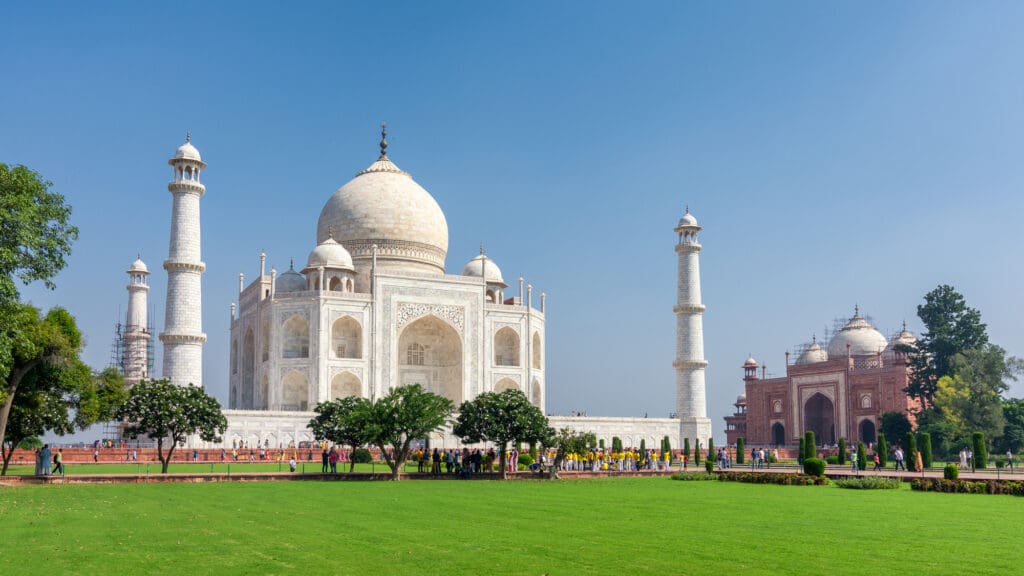
The grandeur of the Taj Mahal lies not only in its symbolic value but also in its intricate architectural features and use of materials. Its central dome, which reaches a height of approximately 73 metres, and the surrounding four smaller domes epitomise the Mughal architecture’s blend with Persian, Islamic, and Indian styles. With a facade of pure marble inlaid with precious and semi-precious stones, the structure reflects light, creating an ethereal glow. The minarets at each corner of the platform add to its magnificent posture, standing as if to guard the precious gem within.
Inside the mausoleum, the detail of the carvings and artistry reveals the extent to which Shah Jahan was willing to immortalise his love for Mumtaz Mahal. The cenotaphs of Shah Jahan and Mumtaz Mahal lie within an octagonal chamber adorned with intricate latticework and pietra dura, an Italian decorative art, illustrating magnificent craftsmanship.
Gardens and Water Features
Surrounding the mausoleum is a four-part garden known as Charbagh, which symbolises paradise in Islamic iconography. This garden is designed geometrically, with pathways that segment the areas and water channels representing rivers leading to the afterlife. The central pathway leads to the Taj Mahal, with fountains embellishing the route, further enhancing the serene atmosphere. These water features not only adorn the garden but also serve a practical purpose, helping to cool the area during the hot Indian summers. The reflection of the Taj Mahal on the water surface of the channels and pools provides a visual representation of the zenith of celestial beauty brought down to Earth.
Evolution of Mosques from Mecca to Istanbul
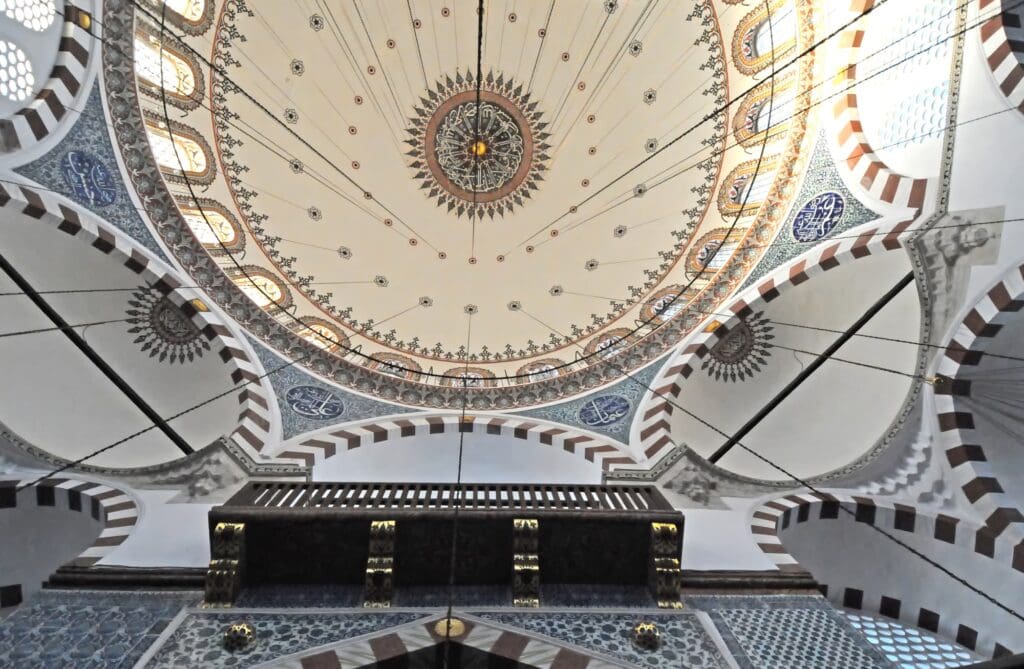
The Islamic world is replete with architectural marvels, and mosques have been the centrepiece of Islamic architecture, reflecting the different eras of the Muslim empire from Mecca to Istanbul. Each structure encapsulates unique elements from the time and place of its creation, portraying a rich legacy of architectural evolution.
Minarets and Domes
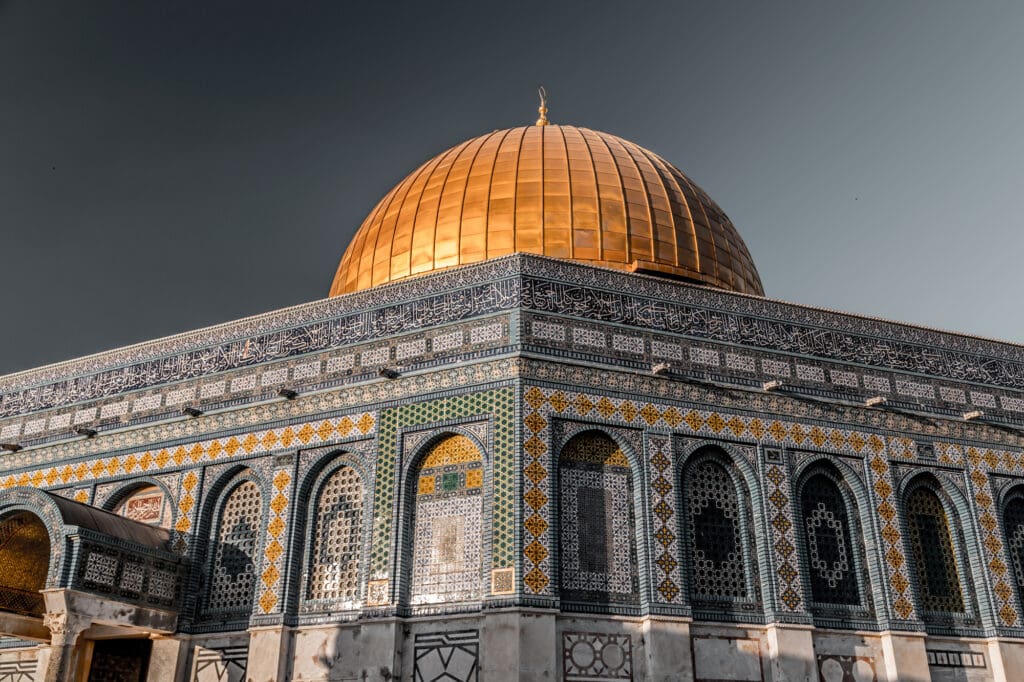
The evolution of mosques is punctuated by the changing designs of minarets and domes, which serve not only as physical features but also as cultural symbols. In Mecca, the Al-Masjid al-Haram began as a simple, open space, evolving with added complex structures over centuries. The Dome of the Rock in Palestine represents one of the earliest architectural marvels of Islam, with its iconic golden dome and octagonal plan serving as a model for future Islamic domes.
As Islam spread, the minaret evolved from a functional tower for the call to prayer to a symbol of Islamic presence. By the time of the Ottoman Empire, minarets had become slender, towering structures, such as those in the Süleymaniye Mosque in Istanbul, which became a signature of Ottoman mosque architecture.
Interior Decoration and Symbolism
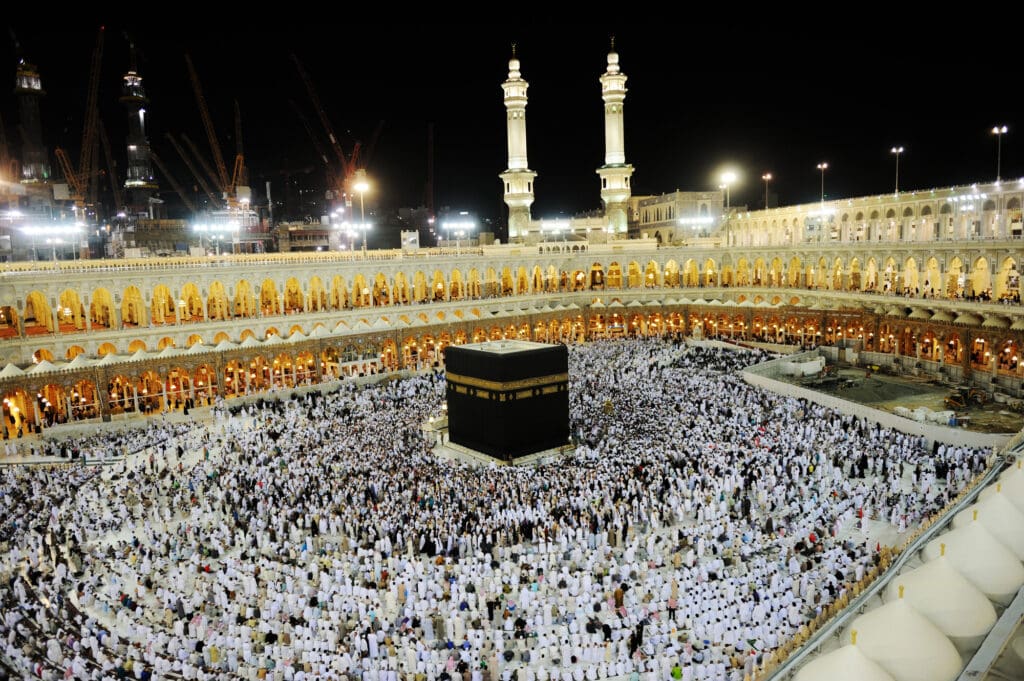
The interiors of mosques also underwent significant transformations, from the austere decorations of the early mosques in Mecca and Medina to the intricate tile work and calligraphy of later periods. Mosques began to incorporate more elaborate forms of art, like the Iznik tiles that adorn many Istanbul mosques, reflecting the value placed on interior aesthetics and the Quranic prohibition against depicting living forms.
In Istanbul, the Blue Mosque, with its cascading domes and six slender minarets, boasts a vast interior space lined with more than 20,000 handmade ceramic tiles in a symphony of blue tones, underscored by the illuminated Quranic calligraphy that adorns its walls, marrying artistic splendour with spiritual symbolism.
Preservation and Adaptation
In the Islamic world, efforts to preserve architectural masterpieces require balancing historical integrity with contemporary needs. This delicate task involves renovating cherished sites while adapting them for modern use.
UNESCO Heritage Sites
The Taj Mahal, a symbol of love and a UNESCO World Heritage Site, has undergone various renovation projects to prevent environmental damage and to preserve its white marble façade for future generations. Similarly, the Alhambra in Spain, a fortress complex representing the pinnacle of Islamic art in Europe, continues to captivate visitors and is maintained with the utmost care, ensuring its survival as a primordial example of Nasrid architecture.
Modern Use of Ancient Spaces
Many ancient Islamic spaces have adapted to contemporary times without forfeiting their historical essence. The Alhambra still welcomes thousands of visitors each year, serving as a learning hub for Islamic history and architecture. Meanwhile, the Taj Mahal remains an active site of worship and a canvas for cultural celebrations, embodying Mughal achievements while appealing to a wide array of international visitors. Both sites stand as testaments to the successful fusion of preservation and adaptation, honouring their past while embracing the present.
The Influence of Islamic Architecture Beyond the Middle East
We observe that Islamic architectural influence extends far beyond its origins in the Middle East, profoundly impacting regions such as North Africa, the Iberian Peninsula, and various parts of Asia. This diffusion not only illustrates the spread of Islam as a religion but also the movement of a rich architectural heritage.
North Africa and the Iberian Peninsula
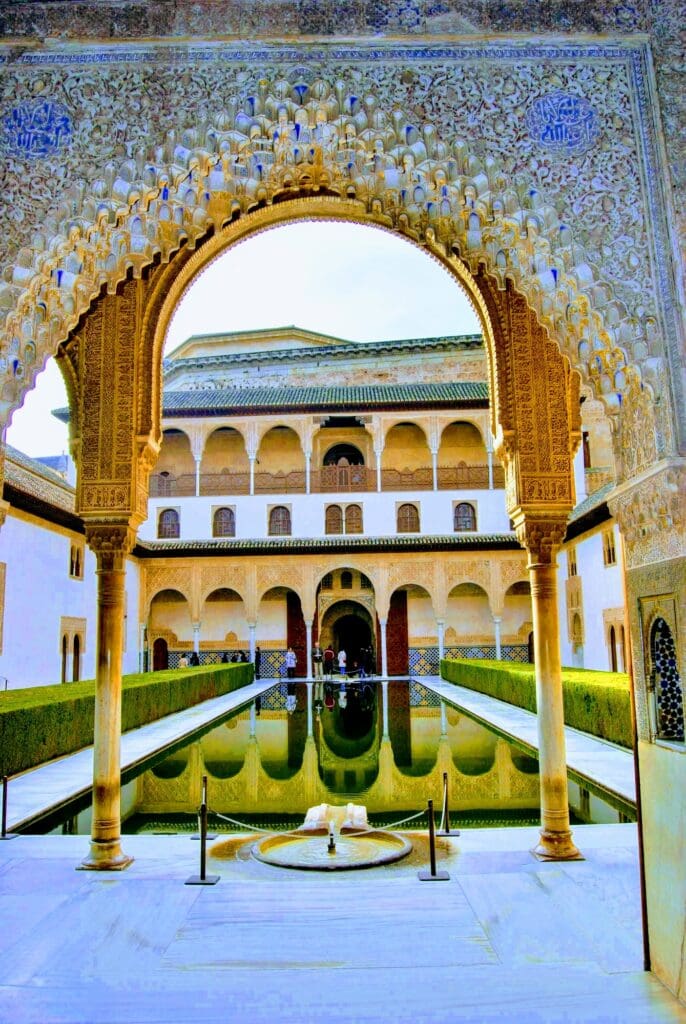
In North Africa, one can witness the grandiosity of Islamic architecture in numerous mosques and madrasas that exhibit key characteristics such as arches, geometric patterns, and courtyards. The legacy of Islamic culture in this region is synonymous with the preservation of Islamic Art, where the intricate tile work of zellige and arabesque motifs stand as a testament to the artistic prowess of Islamic artisans.
Moving to the Iberian Peninsula, we particularly focus on Al-Andalus, an era when Islamic influence was paramount in modern-day Spain and Portugal. The Alhambra in Granada epitomises this with its fortress complex adorned with calligraphy, ornate tile work, and reflecting pools, presenting a harmonious synthesis between architecture and nature. Cities such as Córdoba and Seville still carry the imprints of Islamic influence in their urban fabric, which is manifested in the layout of streets, homes, and the iconic architectural edifices such as the Great Mosque of Córdoba.
Spread to Asia and the Influence of Islam
The architectural influence of Islam dispersed further to the Asian continent, evident in the region’s myriad of mosques, tombs, and palaces. The adoption of Islamic design elements can be seen in the minarets, domes, and intricate calligraphy that bedecks many structures.
As Islam spread to South and Southeast Asia, it also absorbed local architectural traditions, leading to a unique blend of the region’s religious and secular architecture. The Taj Mahal in India remains one of the most iconic examples of Islamic architecture, with its white marble dome and symmetrical gardens reflecting the height of Mughal architectural accomplishment. Likewise, the Sultan Omar Ali Saifuddin Mosque in Brunei, with its modern interpretation of Islamic themes, showcases the continuing evolution of the style in contemporary buildings across the globe.
Islamic Architecture in Contemporary Culture
In our exploration of Islamic architecture, we’ve witnessed its enduring presence, not just as remnants of history but as vibrant elements within contemporary culture. This marriage of past and present can particularly be seen in modern architectural works and travel trends that celebrate these structures as tourist attractions.
Modern Architectural Works
Across the globe, new constructions draw inspiration from the complex geometric patterns and innovative designs characteristic of traditional Islamic architecture. This influence can be seen in award-winning buildings that seamlessly blend modern techniques with historical motifs, reflecting respect for this architectural heritage within a contemporary context.
Islamic Architecture as Tourist Attractions
The iconic silhouettes of minarets and domes continue to captivate tourists, offering a glimpse into the opulent past of Islamic civilisations. Modern travellers often add visits to sites like the Alhambra or the Taj Mahal to their itineraries, acknowledging the profound beauty and timeless appeal of these wonders. In Egypt, the rich Islamic heritage is not just preserved but celebrated and experienced, with bustling bazaars and serene mosques enticing a steady flow of visitors year-round.
In this section, we address some of the most common queries relating to the architectural masterpieces of the Islamic world, encapsulating their defining aspects, historical significance, and evolution through time.
What are the defining characteristics of Islamic architecture?
Islamic architecture is distinguished by features such as intricate geometric patterns, calligraphy, minarets, domes, and iwans. The use of decorative art, including tilework and arabesque motifs, serves both an aesthetic function and represents the unending nature of the divine.
Which monuments are considered the pinnacle of Islamic architectural achievement?
Monuments like the Taj Mahal in India and the Alhambra in Spain are often celebrated as the apex of Islamic architectural achievement, showcasing the culmination of artistic and engineering expertise.
How do the design elements of the Alhambra reflect Islamic architectural principles?
The design elements of the Alhambra embody Islamic architectural principles through their intricate stalactite decorations, serene courtyards, and rhythmic emphasis on water features, all of which harmonise to create a paradisiacal ambience.
In what ways is the Taj Mahal representative of Indo-Islamic architectural styles?
The Taj Mahal reflects Indo-Islamic architectural styles in its grand scale, balance and symmetry, fusion of Persian and Indian design, and detailed inlay work that adorns its surfaces, showcasing an era of rich cultural intersection.
What is the historical significance of Islamic architectural developments throughout the Islamic Empire?
Islamic architectural developments signified the Islamic Empire’s cultural and technological advancements. From grand mosques that served as both religious and educational centres to palaces and public works, these structures have left a lasting legacy on the built environment and the cultural heritage of regions spanning from the Middle East to North Africa and beyond.
How has modern Islamic architecture evolved while maintaining the essence of its traditional roots?
Modern Islamic architecture continues to embody the essence of traditional design by integrating historical elements, such as domes and arches, with contemporary materials and technology. This synthesis respects the past while embracing the opportunities of the present.






